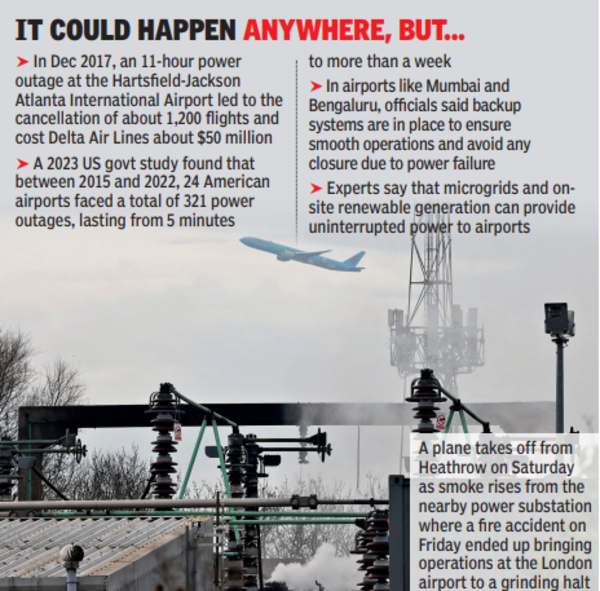The power cut that paralyzed London-Heathrow on Friday was not an isolated incident for the global airline industry, except the scale of flight interruptions, which had no precedents. Ask aviation experts and will tell you that it is more than an operational accident but a warning for the entire airline industry.
A matter of backup
General Director of the International Air Transport Association (IATA) Willie Walsh He expressed the questions now in everyone’s mind. “First, how is that critical infrastructure, of national and global importance, depends totally on a single energy source without an alternative? If that is the case, as it seems, then it is a clear failure of planning by the airport.”
Heather It is the largest center in the United Kingdom, which drives more than 1,300 flights per day. As a comparison, Mumbai airport handles around 950 flights per day. Heathrow had to close after a fire in the North Hyde substation, located about 1.5 miles north of the airport, caused a “significant blackout.” A Heathrow spokesman said that “the backup systems have been functioning as they should, but they do not have the size of administering the entire airport.”

Can such an incident occur at any airport in the world or was it simply the result of Heathrow infrastructure? The experts said that a fire of the substation may not be an exclusive risk of Heathrow, but exposes the difficulties of trusting a single external energy source without sufficient backup systems or supply systems on the site in the form of a lot, wind or diesel generators, etc., etc. The problem is with non -essential operations, the type that involves operations in passenger terminals.
Where are Indian airports
Mumbai’s airport, the second largest airport in India with its two passenger terminals and a cargo terminal, consumes 26.9 MW of energy a day. “We receive energy through two independent and redundant sources (backup). In the case of a source failure, the other can assume 100% of the energy load to guarantee operational continuity. Each terminal obtains electricity from more than one power plant,” said a Mumbai Ltd International Airport (Mial) spokesperson.
There are multiple routes to deliver energy to each terminal. “The system is designed to handle not only one failure, but two consecutive failures without stopping operations. Both the terminals and the airfield have their own diesel generators, with a total capacity of 30 MW. These are activated in the case of a rare and important failure,” said the official. Mumbai airport works with 100% renewable energy, 5% comes from solar generation on the site and 95% of hydroelectric and wind energy. Bangalore Ltd International Airport (Bial) said it uses a highly resistant and redundant energy infrastructure for uninterrupted operations. “BLR airport receives energy from Begur’s substation, which obtains energy through four independent supply lines of different substations,” he said Hari MararMD and CEO, bial. “Bial has also installed a separate transformer in the Begur substation dedicated to airport operations, minimizing the risk of interruptions and also the integrated generation of solar energy on the site and it was to tie with external renewable energy suppliers outside the site, ensuring a constant supply of green energy,” he added.
Pressure to make a green breakdown
Unlike 16 -year -old Bengaluru airport, many important airports depend on the infrastructure designed long before modern digital systems and sustainability requirements became key concerns. While airports have continued to improve the facilities, many continue to depend on obsolete energy networks, centralized energy supply and inherited IT systems that can be difficult to review. Heathrow, for example, opened in 1946 and expanded incremental. Its electrical systems reflect an update mosaic instead of a completely modernized design, an aviation expert said.
Most of the world’s main centers and airports have begun to move towards 2050 net carbon emission objectives (the net objective of India Zero is established by 2070). In the next decades, the demand for electricity at airports will see a strong increase, since it feeds everything from vehicles to airplanes. The movement towards sustainable energy will occur even when terminal buildings and tracks handle increasing volumes of passengers and flights. Airports have begun to prepare for this and “electric resilience” has become a critical aspect of operations in recent years.
How to avoid hypo
It was found that the 40 airports surveyed in an US study were planning or completing electrical infrastructure projects aimed at increasing their energy resistance. These include eliminating air routes for the main food lines of an airport and taking those underground, and updating the infrastructure to remove individual failure points. The latter is exactly the type of update that would avoid a Heathrow crisis.
One of the most promising solutions, which began to find makers in the early 2000s, is the adoption of micro -redes. These are localized grids that can operate independently or in conjunction with the main grid, offering a self -sufficient power supply. Micro -Redes can integrate renewable energy sources such as solar energy and wind. Through these, and together with battery storage and support generators, airports can reduce their dependence on external energy sources. As airports move towards an increasingly electrified future, guaranteeing the reliability of energy is no longer optional. Heathrow interruption should not be another unfortunate event in the history of aviation, it should be a turning point.





